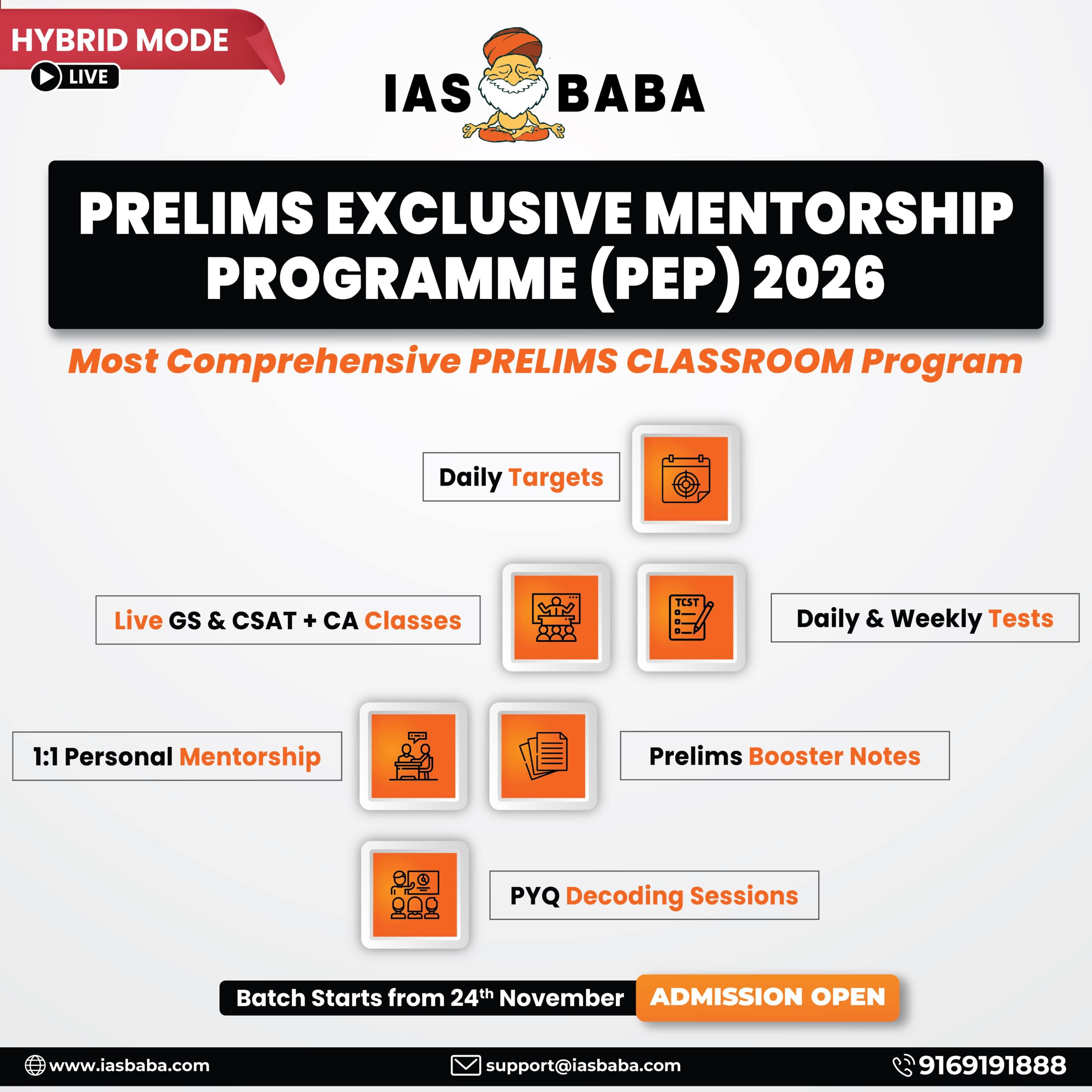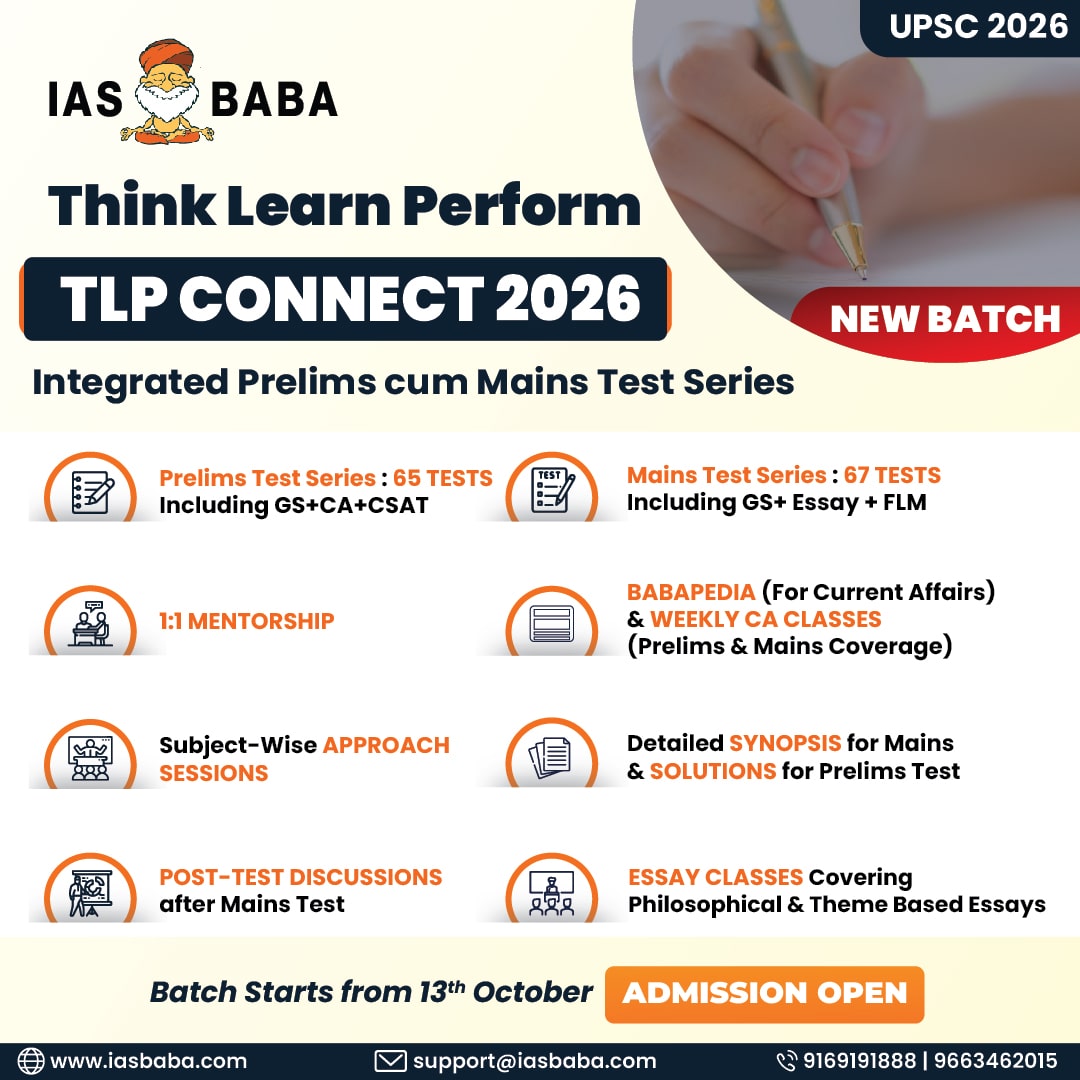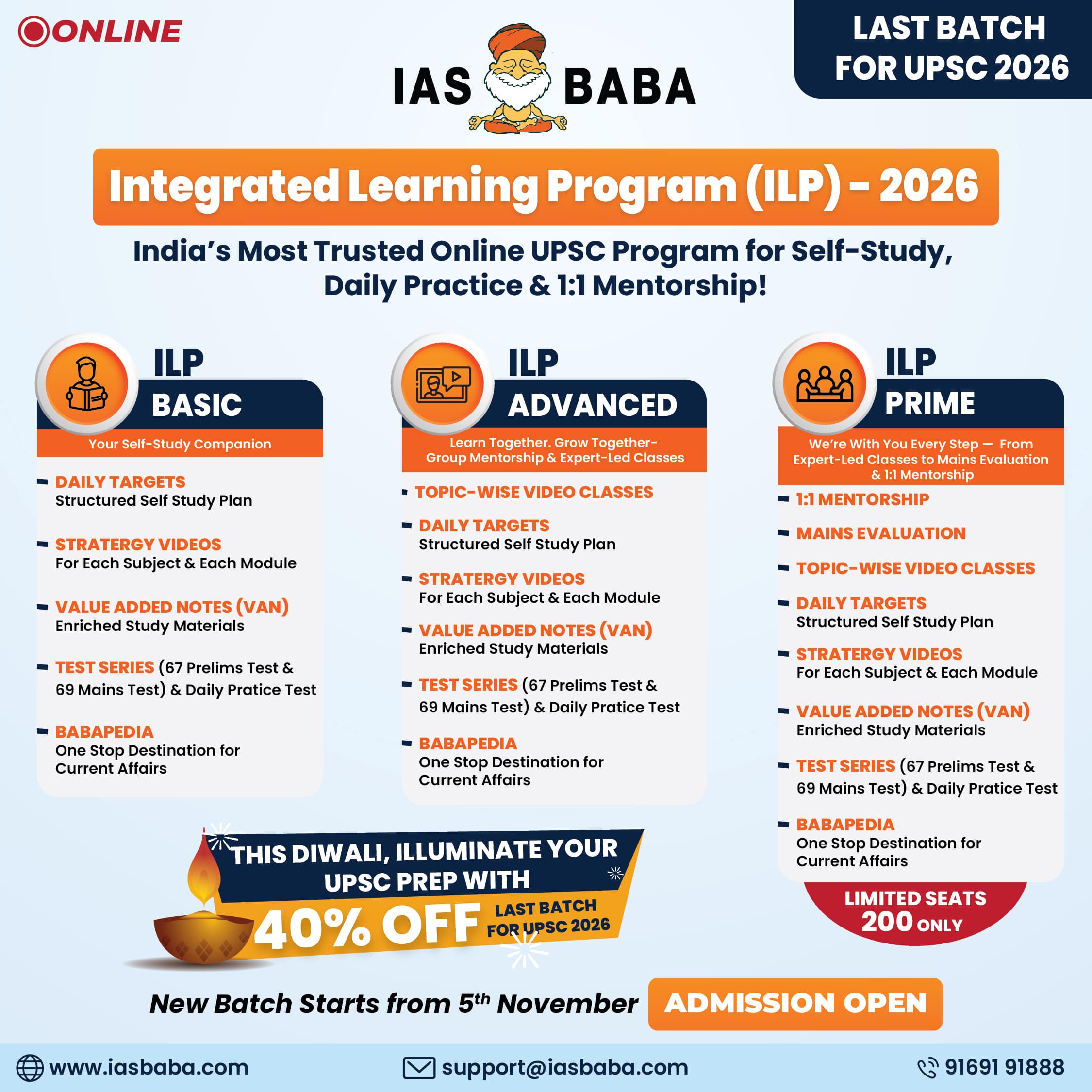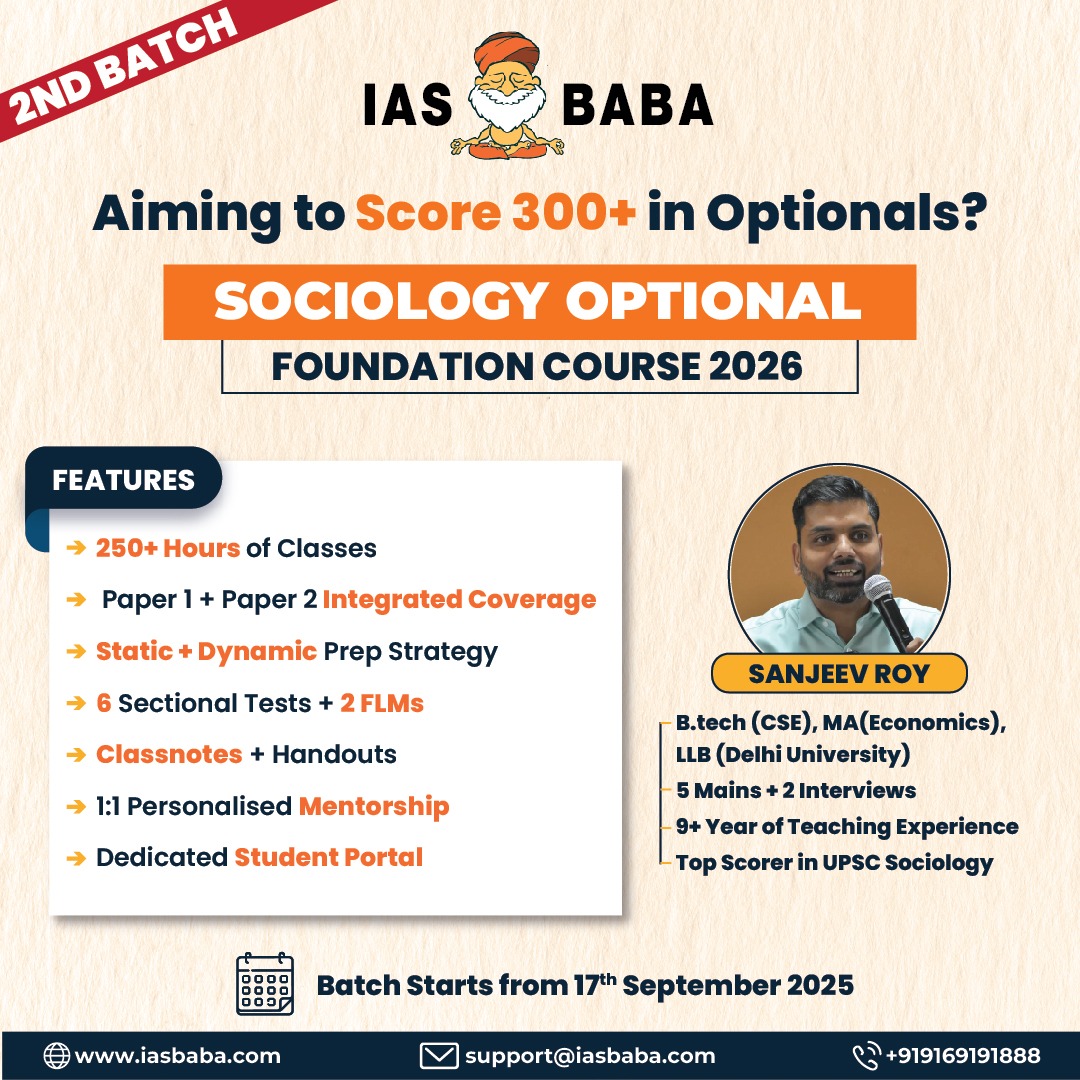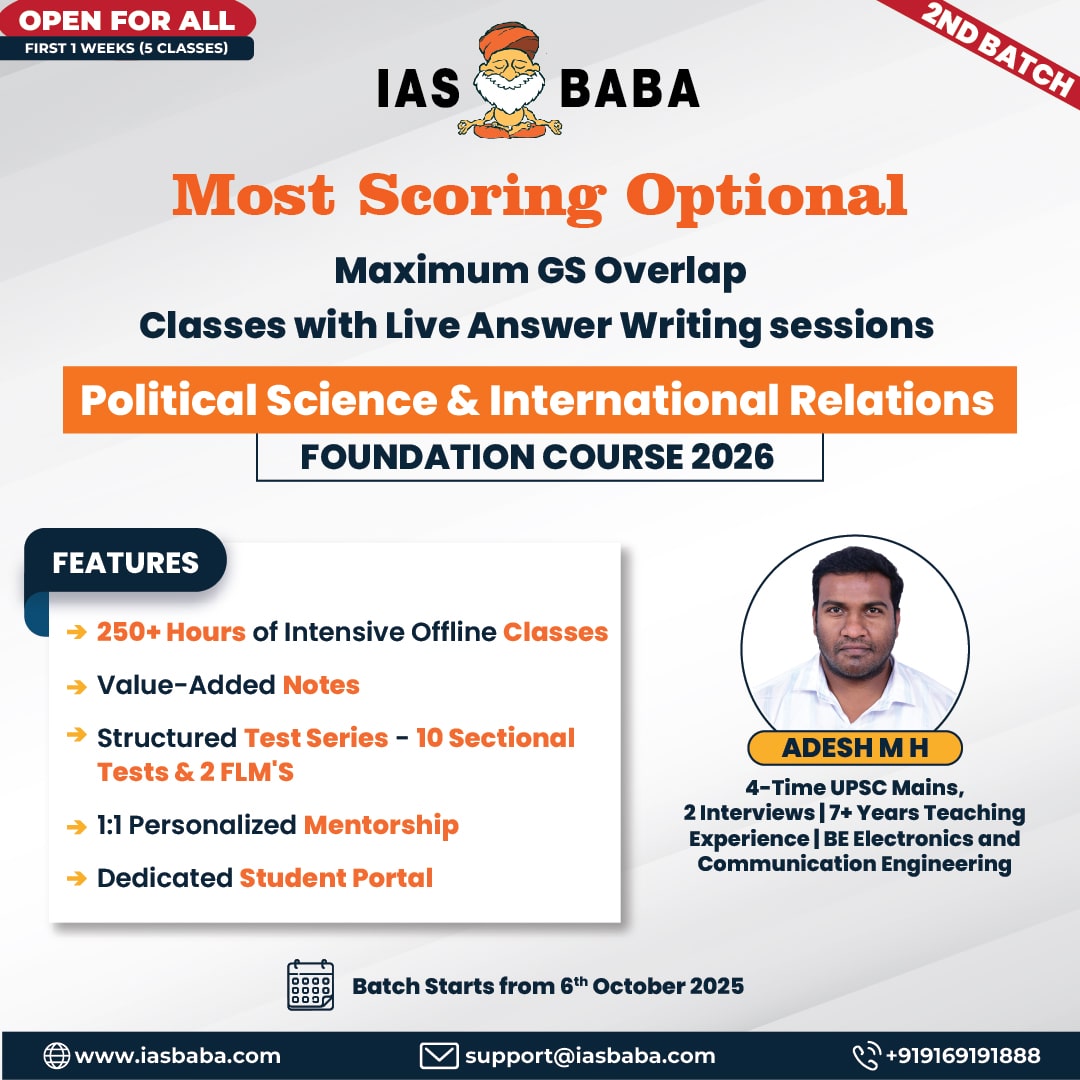IASbaba Daily Prelims Quiz
For Previous Daily Quiz (ARCHIVES) – CLICK HERE
The Current Affairs questions are based on sources like ‘The Hindu’, ‘Indian Express’ and ‘PIB’, which are very important sources for UPSC Prelims Exam. The questions are focused on both the concepts and facts. The topics covered here are generally different from what is being covered under ‘Daily Current Affairs/Daily News Analysis (DNA) and Daily Static Quiz’ to avoid duplication. The questions would be published from Monday to Saturday before 2 PM. One should not spend more than 10 minutes on this initiative.
Gear up and Make the Best Use of this initiative.
Do remember that, “the difference between Ordinary and EXTRA-Ordinary is PRACTICE!!”
Important Note:
- Don’t forget to post your marks in the comment section. Also, let us know if you enjoyed today’s test 🙂
- After completing the 5 questions, click on ‘View Questions’ to check your score, time taken, and solutions.
Test-summary
0 of 5 questions completed
Questions:
- 1
- 2
- 3
- 4
- 5
Information
To view Solutions, follow these instructions:
- Click on – ‘Start Test’ button
- Solve Questions
- Click on ‘Test Summary’ button
- Click on ‘Finish Test’ button
- Now click on ‘View Questions’ button – here you will see solutions and links.
You have already completed the test before. Hence you can not start it again.
Test is loading...
You must sign in or sign up to start the test.
You have to finish following test, to start this test:
Results
0 of 5 questions answered correctly
Your time:
Time has elapsed
You have scored 0 points out of 0 points, (0)
| Average score |
|
| Your score |
|
Categories
- Not categorized 0%
| Pos. | Name | Entered on | Points | Result |
|---|---|---|---|---|
| Table is loading | ||||
| No data available | ||||
- 1
- 2
- 3
- 4
- 5
- Answered
- Review
-
Question 1 of 5
1. Question
-
With reference to mortality indicators in India, consider the following pairs:
Indicator Measurement Unit 1. Infant Mortality Rate (IMR) Deaths of infants under 1 year per 1,000 live births 2. Maternal Mortality Ratio (MMR) Maternal deaths per 1,000 live births 3. Neonatal Mortality Rate (NMR) Deaths of newborns within 28 days per 1,000 live births 4. Under-5 Mortality Rate (U5MR) Deaths of children under 5 years per 1,000 live births How many of the pairs given above are correctly matched?
Correct
-
Solution: (c)
Explanation:
- Pair 1 (IMR): Infant deaths (under 1 year) per 1,000 live births. This is Correct
- Pair 2 (MMR): It is maternal deaths per 100,000 live births, not per 1,000. This is Incorrect
- Pair 3 (NMR): Deaths within 28 days per 1,000 live births. This is Correct
Pair 4 (U5MR): Deaths under 5 years per 1,000 live births. This is Correct
Incorrect
-
Solution: (c)
Explanation:
- Pair 1 (IMR): Infant deaths (under 1 year) per 1,000 live births. This is Correct
- Pair 2 (MMR): It is maternal deaths per 100,000 live births, not per 1,000. This is Incorrect
- Pair 3 (NMR): Deaths within 28 days per 1,000 live births. This is Correct
Pair 4 (U5MR): Deaths under 5 years per 1,000 live births. This is Correct
-
-
Question 2 of 5
2. Question
-
Consider the following statements about the election of the President and Vice-President of India:
-
In the Presidential election, the vote value of MPs and MLAs is weighted to maintain parity between the Union and the States, whereas in the Vice-Presidential election, all MPs have equal vote value.
-
While both elections use the system of proportional representation by means of the single transferable vote, only in the Presidential election is the concept of vote value applied.
-
In case of disputes regarding either election, the matter is decided by the Election Commission of India, subject to approval by the Supreme Court.
Which of the statements given above is/are correct?
Correct
-
Solution: (b)
Explanation:
- Statement 1: In Presidential election, vote value of MPs/MLAs is calculated to balance Union-State federal principle; in Vice-Presidential election, each MP’s vote carries equal value. This statement is Correct
- Statement 2: Both elections use proportional representation (STV), but only Presidential election involves vote value formula. This statement is Correct
Statement 3: Disputes are adjudicated directly by the Supreme Court (Article 71), not by ECI with SC approval. This statement is Incorrect
Incorrect
-
Solution: (b)
Explanation:
- Statement 1: In Presidential election, vote value of MPs/MLAs is calculated to balance Union-State federal principle; in Vice-Presidential election, each MP’s vote carries equal value. This statement is Correct
- Statement 2: Both elections use proportional representation (STV), but only Presidential election involves vote value formula. This statement is Correct
Statement 3: Disputes are adjudicated directly by the Supreme Court (Article 71), not by ECI with SC approval. This statement is Incorrect
-
-
Question 3 of 5
3. Question
-
Consider the following statements:
-
The International Criminal Court (ICC) is an organ of the United Nations, established by the UN Charter in 1945.
-
The ICC can exercise jurisdiction over crimes referred to it by the UN Security Council, even if the state concerned is not a party to the Rome Statute.
Which of the statements given above is/are correct?
Correct
-
Solution: (b)
Explanation:
- Statement 1: The ICC is not a UN organ; it is an independent body established by the Rome Statute (1998, effective 2002). This statement is Incorrect
Statement 2: The UN Security Council can refer cases to the ICC (e.g., Darfur, Libya), even if the concerned state is not a party to the Rome Statute. This statement is Correct
Incorrect
-
Solution: (b)
Explanation:
- Statement 1: The ICC is not a UN organ; it is an independent body established by the Rome Statute (1998, effective 2002). This statement is Incorrect
Statement 2: The UN Security Council can refer cases to the ICC (e.g., Darfur, Libya), even if the concerned state is not a party to the Rome Statute. This statement is Correct
-
-
Question 4 of 5
4. Question
The Engineering Export Promotion Council (EEPC) India, recently in news, functions under which Ministry?
Correct
-
Solution: (b)
Explanation:
The Engineering Export Promotion Council (EEPC) India is the premier trade promotion organization in India dedicated to the promotion of engineering goods, projects, and services exports. It was set up by the Ministry of Commerce & Industry, Government of India, in 1955.
Key points:
- Objective: To promote and facilitate the export of engineering goods and services from India.
- Functions:
- Organizes trade fairs, buyer-seller meets, and business delegations abroad.
- Provides export-related advisory and support services to Indian engineering exporters.
- Liaises with the government on trade policies affecting the engineering sector.
Incorrect
-
Solution: (b)
Explanation:
The Engineering Export Promotion Council (EEPC) India is the premier trade promotion organization in India dedicated to the promotion of engineering goods, projects, and services exports. It was set up by the Ministry of Commerce & Industry, Government of India, in 1955.
Key points:
- Objective: To promote and facilitate the export of engineering goods and services from India.
- Functions:
- Organizes trade fairs, buyer-seller meets, and business delegations abroad.
- Provides export-related advisory and support services to Indian engineering exporters.
- Liaises with the government on trade policies affecting the engineering sector.
-
Question 5 of 5
5. Question
-
Consider the following statements:
Statement I:
During a total lunar eclipse, the Moon appears red due to Earth’s atmosphere filtering sunlight.Statement II:
During a partial lunar eclipse, only a part of the Moon enters the Earth’s umbra, while the rest remains illuminated.Statement III:
Both partial and total lunar eclipses occur only during the full moon phase.Which one of the following is correct in respect of the above statements?
Correct
-
Solution: (b)
Explanation:
- Statement I: The red color of the Moon during a total lunar eclipse is due to Rayleigh scattering and refraction of sunlight through Earth’s atmosphere, which filters out blue light and bends red light onto the Moon. This statement is Correct
- Statement II: In a partial lunar eclipse, only part of the Moon passes through Earth’s umbra, and the rest remains lit. This statement is Correct
- Statement III: Both partial and total lunar eclipses occur only on full moon days, when Sun, Earth, and Moon align in a straight line (syzygy). This statement is Correct
- Linkage:
Statement II and III describe the conditions of lunar eclipses, but only Statement III indirectly explains why Statement I can occur (since a total eclipse is possible only on a full moon night).
Hence, II + III are correct, but only III explains I.
Incorrect
-
Solution: (b)
Explanation:
- Statement I: The red color of the Moon during a total lunar eclipse is due to Rayleigh scattering and refraction of sunlight through Earth’s atmosphere, which filters out blue light and bends red light onto the Moon. This statement is Correct
- Statement II: In a partial lunar eclipse, only part of the Moon passes through Earth’s umbra, and the rest remains lit. This statement is Correct
- Statement III: Both partial and total lunar eclipses occur only on full moon days, when Sun, Earth, and Moon align in a straight line (syzygy). This statement is Correct
- Linkage:
Statement II and III describe the conditions of lunar eclipses, but only Statement III indirectly explains why Statement I can occur (since a total eclipse is possible only on a full moon night).
Hence, II + III are correct, but only III explains I.
-
- Current Affairs Quiz, IAS Daily Current Affairs Quiz, IAS UPSC Current Affairs Quiz, IAS UPSC Prelims Quiz, IASbaba's Current Affairs Prelims Quiz, IASbaba's Daily Quiz, IASbaba's UPSC Quiz, Prelims Current Affairs Quiz, UPSC Current Affairs Quiz, UPSC Current Affairs Quiz IASbaba, UPSC Daily Current Affair Quiz, UPSC IAS Daily Quiz




